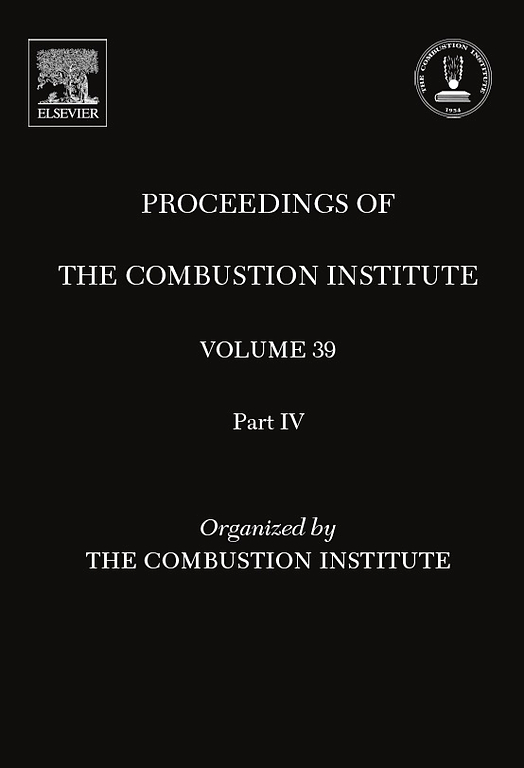Identification of entropy waves in a partially premixed combustor
IF 5.3
2区 工程技术
Q2 ENERGY & FUELS
引用次数: 0
Abstract
Unsteady combustion generates not only acoustic waves, but also fluctuations of the burnt gas temperature — referred to as entropy waves. These waves are convected by the mean flow through the combustor and result in conversion to acoustic energy when accelerated in an exit nozzle. The upstream traveling acoustic wave can then couple with the unsteady heat release of the flame and cause self-excited thermoacoustic instability, particularly at low frequencies (“rumble”). In this work, large eddy simulation (LES) is combined with system identification (SI) to determine the entropy transfer function (ETF) of a partially premixed, swirl-stabilized flame with hydrogen enrichment. We compare the single-input single-output (SISO) entropy transfer function identified from a broadband-forced LES with air mass flow modulation to the one obtained experimentally through tunable diode laser absorption spectroscopy with wavelength modulation spectroscopy (TDLAS-WMS) to measure temperature fluctuations. Then, multiple-input single-output (MISO) identification is applied to time series data obtained from simultaneous modulation of air and fuel mass flow to estimate the individual contributions of perturbations in velocity and equivalence ratio to entropy response. Equivalence ratio fluctuations are found to be the dominant generation mechanism of entropy waves. Finally, the entropy transfer function is identified at various positions in the combustion chamber to analyze the decay of entropy waves governed by convective dispersion.识别部分预混燃烧器中的熵波
非稳态燃烧不仅会产生声波,还会产生燃烧气体温度的波动,即熵波。这些波由通过燃烧器的平均气流对流,在出口喷嘴中加速后转化为声能。然后,上游行进的声波会与火焰的不稳定热释放耦合,导致自激热声不稳定性,尤其是在低频("隆隆声")时。在这项研究中,大涡流模拟(LES)与系统识别(SI)相结合,确定了氢气富集的部分预混漩涡稳定火焰的熵传递函数(ETF)。我们将通过空气质量流量调制宽带强迫 LES 确定的单输入单输出(SISO)熵传递函数与通过可调谐二极管激光吸收光谱与波长调制光谱(TDLAS-WMS)测量温度波动实验获得的熵传递函数进行了比较。然后,对同时调制空气和燃料质量流量获得的时间序列数据进行多输入单输出(MISO)识别,以估算速度和等效比扰动对熵响应的单独贡献。结果发现,等效比波动是熵波的主要产生机制。最后,确定了燃烧室中不同位置的熵传递函数,以分析对流扩散所控制的熵波衰减。
本文章由计算机程序翻译,如有差异,请以英文原文为准。
求助全文
约1分钟内获得全文
求助全文
来源期刊

Proceedings of the Combustion Institute
工程技术-工程:化工
CiteScore
7.00
自引率
0.00%
发文量
420
审稿时长
3.0 months
期刊介绍:
The Proceedings of the Combustion Institute contains forefront contributions in fundamentals and applications of combustion science. For more than 50 years, the Combustion Institute has served as the peak international society for dissemination of scientific and technical research in the combustion field. In addition to author submissions, the Proceedings of the Combustion Institute includes the Institute''s prestigious invited strategic and topical reviews that represent indispensable resources for emergent research in the field. All papers are subjected to rigorous peer review.
Research papers and invited topical reviews; Reaction Kinetics; Soot, PAH, and other large molecules; Diagnostics; Laminar Flames; Turbulent Flames; Heterogeneous Combustion; Spray and Droplet Combustion; Detonations, Explosions & Supersonic Combustion; Fire Research; Stationary Combustion Systems; IC Engine and Gas Turbine Combustion; New Technology Concepts
The electronic version of Proceedings of the Combustion Institute contains supplemental material such as reaction mechanisms, illustrating movies, and other data.
 求助内容:
求助内容: 应助结果提醒方式:
应助结果提醒方式:


